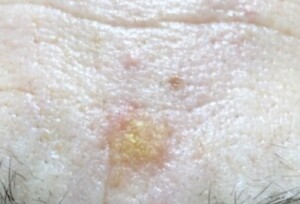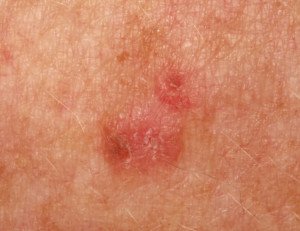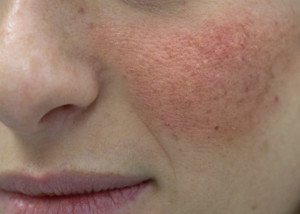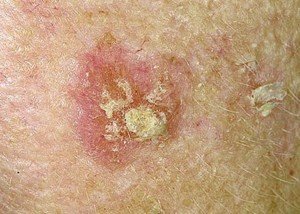
If a dermatologist tells you the rough red or pink patches on your face are seborrheic dermatitis, beware:
They may be actinic keratosis mimicking the more benign condition.
Actinic keratosis is damage from the sun that, if left untreated, has a 10 percent chance of developing into a skin cancer called squamous cell carcinoma.
I have a history of actinic keratosis lesions, which were removed via a spray of liquid nitrogen or a prescription cream. mimic
I know exactly what AKs look like and how they feel to the fingertips. mimic
I also have a history of seborrheic dermatitis, a harmless though potentially very itchy and mildly burning, and sometimes unsightly, condition. There is a mild overlap in how these conditions appear to the naked eye.
Though seborrheic dermatitis can peel, flake and even ooze, it doesn’t always do this. Sometimes there’s only a pinkish rough patch of skin.

Patch of pinkish yellow seborrheic dermatitis
So how does actinic keratosis mimic seborrheic dermatitis?
In my opinion, it isn’t that difficult to tell the two conditions apart—even when the SD is only a rough patch minus the flaking and scaling.
They can both be described as pinkish or even reddish, but the BIG DIFFERENCE between mild seborrheic dermatitis and early actinic keratosis is that the SD typically has an orange tinge to its pink or reddish patch. mimic
It’s more like a pinkish orange, almost like salmon, whereas an AK is 100 percent pink/red, without even the tiniest hint of orange.
And that sandpaper feel on the fingertips is just plain unmistakable.

Patch of actinic keratosis. Shutterstock/Dermatology11
As an AK progresses, however, a brownish or tan scabbing can form.
A year and a half ago I began noticing the development of the classic red-pink areas of very early actinic keratosis.
I brought it up to my regular dermatologist during my routine skin exam and she brushed them off as seborrheic dermatitis. I acted surprised but she assured me that’s what they were.
When I saw a second dermatologist (for mole mapping; not the same clinic), I didn’t mention anything about the suspected AKs.
Yet that dermatologist, plus the fourth-year resident with her, did not say anything about the dark pink patches! mimic
I thought, “Okay, maybe they ARE seborrheic dermatitis.” But over time they were becoming a more intense pink.
When I saw the original dermatologist 18 months later for another routine skin exam, I said nothing as she inspected my skin.
She noted the flare-up of my seborrheic dermatitis, which looked nothing like the actinic keratoses. The patches of both conditions were on various areas of my face. mimic
Finally I pointed to the AKs and said, “I think these are AKs. I just know they are.”
She said they were SDs. I responded, “Are you sure? How can that be? They look and feel like AKs.”
She then mentioned something about the come-and-go nature of SDs. I responded, “But these do not come and go or flare up. They are ALWAYS there. ALWAYS.”
She then took the canister of liquid nitrogen off her desk and began spraying.
Moral of story: If your gut, or eyes or fingertips tell you that you have actinic keratoses – and the dermatologist assures you that they are seborrheic dermatitis – by golly, point out that they are ALWAYS THERE – ALWAYS.
Or, if you decide to stay silent to see if the dermatologist mentions anything about them, this does NOT mean they are SDs.
Speak up! I don’t know why I didn’t the first time. Maybe it’s because I know that AKs are extremely slow-growing, and that treatment is a slam-dunk. But that shouldn’t stop you from speaking up.


























